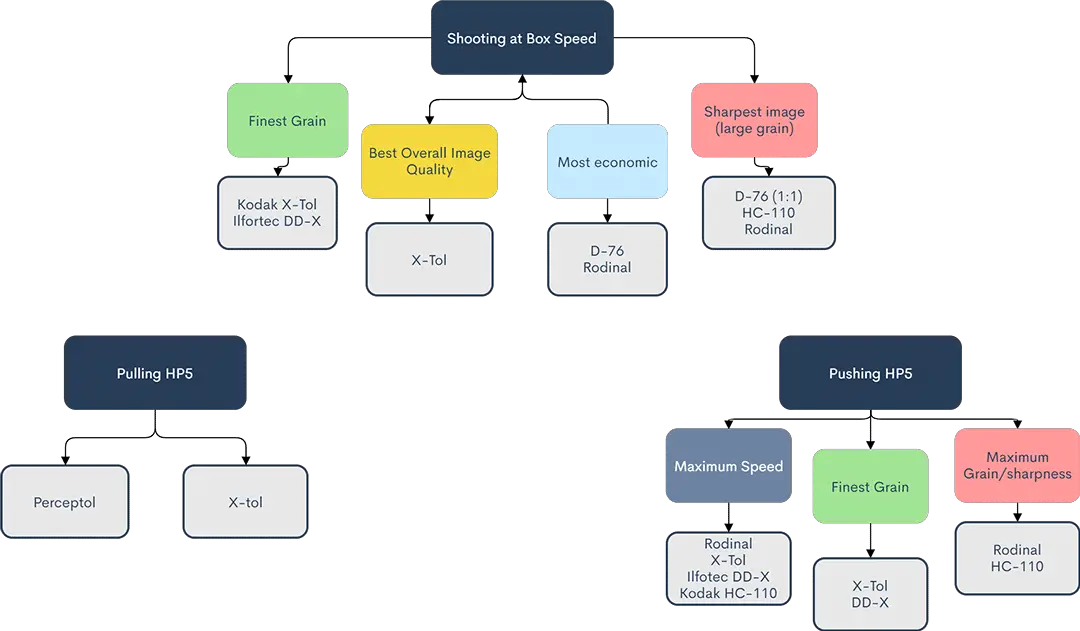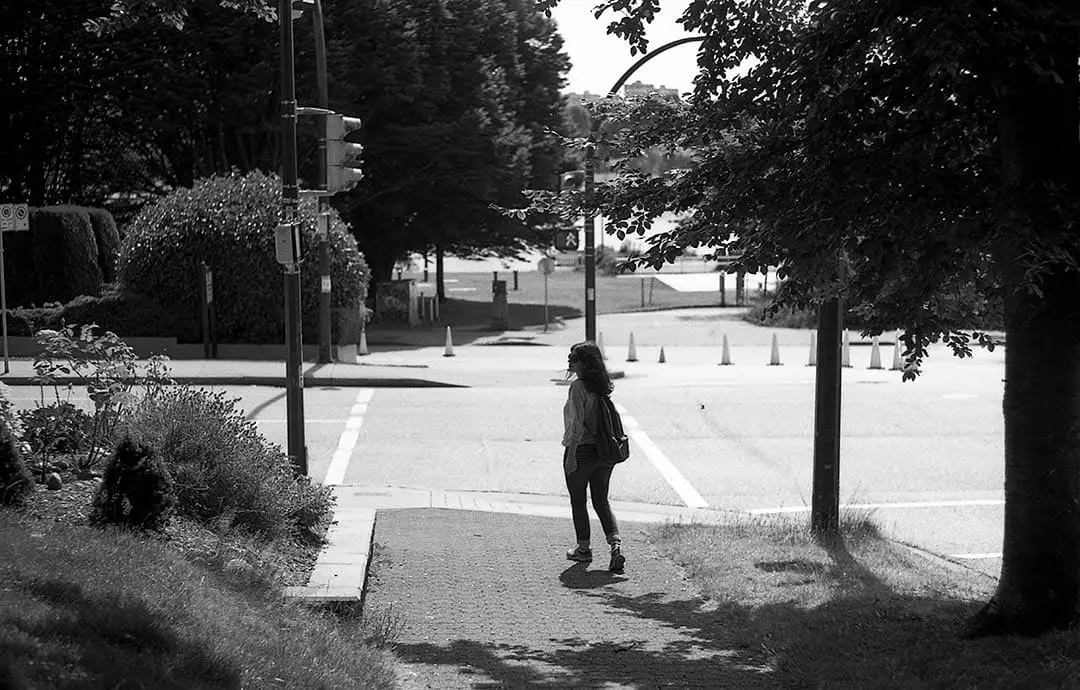Tri-X is one of the most common film stocks on the market, and for good reason. It’s a classic Kodak film that is immensely flexible, and notable for beautiful grain structure and contrast.
But there are many times when ISO 400 just isn’t enough for daily life. What if you want to shoot a fast shutter speed to capture late evening motion? Or for street photography after dark?
Kodak’s Tri-X 400 is rated for exposure between ISO 200 and 3200, but can be pushed up to ISO 12,800, and pulled to ISO 50. In practice, Tri-X can be pushed or pulled one stop and developed normally without any significant changes.
Tri-X is the second most flexible film stock on the market, sitting just behind Ilford’s HP5, according to Bill Troop and Steve Anchell’s 2019 The Film Developing Cookbook. It has the finest grain of any Non-T-grain ISO 400 film and is prized for rich tonality in a wide variety of shooting scenarios, making it the de-facto street and photojournalistic film.
Tri-X is one of the best-selling films on the planet, reportedly taking up as much as 80% of all B&W sales, according to Troop & Anchell. It’s a film stock that I’ve worked with a lot over the years, and here are my tried and true tips for getting the most out of this film stock.

What is the best, all-around developer for pushing and pulling Tri-X?
Developer choice is largely a matter of personal preference, but there are some developers that will work better than others for pushing Tri-X. The most up to date information typically comes from the Technical Data Sheets published by the companies, or independent, well-researched, professional sources like Troop and Anchell. So what do these resources say about developing Tri-X?
The overall best developer for producing negatives with rich tonality and fine-grain structure is Kodak Xtol. This developer can be used to produce good negatives from ISO 50 all the way to ISO 6400.
Xtol is the latest, and likely the last film developer to ever be created by Kodak. It was formulated to be eco-friendly, and create fine-grain results. When Xtol is diluted 1:1, it is known for keeping film sharp and pushing extremely well.
There’s only one downside to Xtol. And it’s the fact that Xtol is a powdered developer that has to be mixed into a 5L solution. And once it’s mixed, that solution is only rated to last 6 months, but with good storage, it is possible to make it last longer.
The next best developer for pushing Tri-X is Ilford’s DD-X. This is one of my favorite developers for pushing film because it creates rich shadow details unlike any other liquid developer. Despite the higher price, I always keep a bottle of DD-X on my shelf for pushing and pulling black and white film. Get a bottle of DD-X on Amazon here.
| Developer | Maximum Push | Dilution | Development Type |
| Rodinal | 12,800 | 1+50 | Semi-stand* for 51 min |
| HC-110 | 6400 | 1+31 | 26 min at 20°C (68°F) |
| Xtol | 6400 | Stock | 13.5 min at 24°C (75°F) |
| DD-X | 6400 | 1+4 | 25 min at 20°C (68°C) |
| D-76 | 3200 | 1+1 | 16 min at 20°C (68°F) |
Developers that Produce the Maximum Film Speed and Sharpness
One of the biggest choices that you have to make when choosing a developer is between grain size and sharpness. If you want fine-grain results, you’re going to sacrifice some acutance, or sharpness in the image.
Sharpness on film comes at the cost of having visible grains — especially when pushing. Fine grain developers like D-76 will eat away at the edges of the grain to make them appear smaller, but that does reduce the sharpness of the image. See a comparison between DD-X, HC-110, Black, White, and Green, Rodinal, and D-76 here.
When you’re looking for maximum sharpness, speed, economy, and shelf-life, Rodinal (Blazinol in Canada) is the ideal option. This developer is a high-acutance developer, meaning it doesn’t at all reduce the appearance of grain on film.
If you love grains and only develop film every now and then, Rodinal is the best film developer choice. There’s an old joke that the shelf life of an opened bottle of Rodinal is longer than the shelf itself.
The next choice most photographers make is Kodak’s own HC-110. HC-110 is technically a fine-grain developer at Dilution A. When it’s used at Dilution B, much of the solvent action that reduces grain appearance disappears.
The new HC-110 formulation doesn’t last as long as the older ones. So make sure to separate it into smaller bottles to keep it lasting as long as possible.
Check out this article to learn about the top developers that increase sharpness in your negatives.

How stand developing can save your shadow details
One of the major benefits of using a traditional structure film like Tri-X over a T-grain film like TMax 400 is that you have much more tonal flexibility. Traditional grains typically have a wider latitude and tonal range than T-Grains. But they sacrifice a bit of sharpness, and have larger-appearing grains. But this wide-tonality is what makes traditional-grain films so good for pushing and pulling.
But as mentioned about, pushing more than 2 stops will usually result in a huge loss of shadow details. To give your film the best chance of having anything in the shadows, there’s a technique called stand development that works wonders.
Stand developing is when you use a very dilute solution like Rodinal 1+100 and only agitate the film for the first minute. After that, let the film stand without agitation in the tank for up to 2.5 hours.
The theory behind stand development is that the developer will quickly exhaust itself in the very dense highlights. In the shadows, though, the developer keeps working, finding new grains to reduce into metallic silver. If you agitate the film, it’ll bring more fresh developer into the highlights, which can become so dense that they’re essentially unworkable. Semi-stand developing works the same way, but it requires gentle agitation every hour or half hour depending on the recipe.
This is a brilliant solution that can ensure you’re getting everything possible out of the shadows without creating unworkable contrast. Be sure to try it out when you’re push developing!

What are the best developers for pulling Tri-X?
If you’re shooting in a high-contrast situation, a common technique to produce stunning, fine-grain, darkroom-workable negatives is to over-expose. Over-exposing by 1 stop or more can produce dense negatives that are far more flexible when printing. Many photographers swear by always over-exposing film by a stop or more to produce the best possible film results.
The best developers for pulling Tri-X are Perceptol and Xtol. Perceptol is known for reducing image speed and producing exceptionally fine-grain results. Xtol doesn’t have as much solvent action, but will produce beautiful, dense, and sharp images when Tri-X is overexposed one or more stops.
It’s important to note that pulling too far can reduce the sharpness in negatives. If you’re scanning with a DSLR or Flatbed scanner, producing negatives that are too dense can require these machines to increase their ISO, immensely reducing the quality of the scanned image. As well, Ilford technical data sheets note that negatives that are too dense will often lack contrast, and reduce the sharpness in the resulting negative.
That said, film negatives love light. They can typically resolve much more detail in the highlights than they can in the shadows. This means images will be the most flexible when exposing for the shadows. That way you can get as much detail out of the scene as possible.
How do you shoot and develop Tri-X? Leave a comment below, or send me a DM on Instagram! I always love hearing what everyone reading is doing with all of these insanely fun films.

By Daren
Daren is a journalist and wedding photographer based in Vancouver, B.C. He’s been taking personal and professional photos on film since 2017 and began developing and printing his own photos after wanting more control than what local labs could offer. Discover his newest publications at Soft Grain Books, or check out the print shop.



Hi, you mentioned Ilford perceptol as good for pushing tri-x 400, but it is not in the chart on this page, what would you recommend for pushing to 1600? Thanks
Hi Michael,
Perceptol is good for pulling film, but it is not a good developer for pushing. I’d highly recommend using something like xtol, HC-110, or Rodinal for pushing Tri-X to 1600.